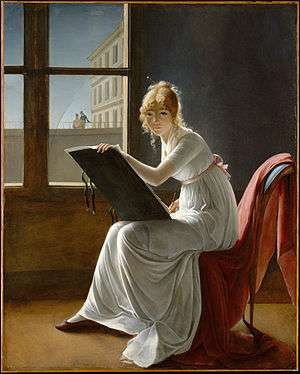Marie-Denise Villers
| Marie-Denise Villers | |
|---|---|
 Marie-Denise Villers, Young Woman Drawing, 1801, oil on canvas.
Metropolitan Museum of Art, New York City | |
| Born |
Marie-Denise Lemoine 1774 Paris |
| Died | 19 August 1821 (aged 46–47) |
| Known for | Portrait painting |
| Movement | Neoclassicism |
Marie-Denise Villers (née Lemoine; 1774 – 19 August 1821) was a French painter who specialized in portraits.
Life
Villers was born Marie-Denise Lemoine in Paris. She came from an artistic family, and her sisters Marie-Victoire Lemoine and Marie-Élisabeth Gabiou were also accomplished artists.
In 1794, she married an architecture student, Michel-Jean-Maximilien Villers. Villers was a student of the French painter Anne-Louis Girodet de Roussy-Trioson and also took lessons with François Gérard and Jacques-Louis David.
Career
She first exhibited artwork at the Paris Salon of the Year VII (1799). Villers' most famous painting, Young Woman Drawing, (1801) is displayed in the Metropolitan Museum of Art. The painting was initially attributed to Jacques-Louis David and then to another of his female pupils, Constance Marie Charpentier, but is now recognized as Villers' work.[1] Art historian Anne Higonnet argues that Young Woman Drawing is a self-portrait.[2]
Villers exhibited Study of a young woman sitting on a window and two other works at the Salon of 1801, followed in 1802 by a genre painting entitled A child in its cradle and A Study of a Woman from Nature.[3] Her last known work is a portrait of the Duchess of Angoulême, exhibited in 1814.
Works
- "La Peinture. Une Bacchante endormie", 1799. (Painting. A Bacchante sleeping)
- "Étude d’une jeune femme assise sur une fenêtre", 1800-1801. (Study of a young woman sitting on a window)
- "Jeune femme dessinant," (Young woman drawing) previously known as Portrait of Miss Charlotte du Val Ognes, New York, Metropolitan Museum of Art, 1801.
- "Étude d’une femme à sa toilette". portrait, 1801. (Study of a woman at her toilet.)
- "Une étude de femme d’après nature," Presumed Portrait of Madame Soustras, Paris, Louvre Museum, 1802[3]
- "Un enfant dans son berceau, entrainé par les eaux de l’inondation du mois de Nivôse an X", 1802. (A child in its cradle, driven by the flood waters of the month X year Nivôse)
- "Un enfant dans son berceau, entrainé par les eaux de l’inondation du mois de Nivôse an X", taille réduite de l’œuvre de 1802, 1810. (A child in its cradle, driven by the flood waters of the month Nivôse year X)
- "Une petite fille blonde, tenant une corbeille de jonc remplie de fleurs"; before 1813. (A little blonde girl holding a basket filled with flowers ring)
- "Portrait de la duchesse d’Angoulême", 1814. (Portrait of the Duchess of Angoulême)
References
- ↑ Hess, Thomas B. (1971). "Editorial: Is Women's Lib Medieval?". ARTnews. 69 (9).
- ↑ Higonnet, Anne. “White Dress, Broken Glass: Starting All Over Again in the Age of Revolution.” Norma Hugh Lifton Lecture. School of the Art Institute, Chicago. October 2011.
- 1 2 Harris, Ann Sutherland and Linda Nochlin. Women Artists:1550-1950. Alfred A. Knopf, New York (1976). 217.
External links
| Wikimedia Commons has media related to Marie-Denise Villers. |